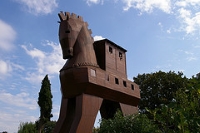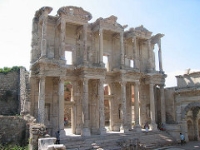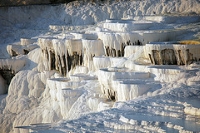
For about 3,000 years the legend the battle of Troy pervaded Western culture. The story, told by Homer in the Iliad, was regarded as just a myth, until the ruins of the city were found at Hisarlik, in western Turkey, in the mid-19th century.Today the romantic story draws tourists and archaeologists alike to the site, where not a great deal remains to be seen beyond the ancient walls and a replica of the famed Trojan horse which enabled the final conquering of the city by the ancient Greeks. The setting is also spectacular, offering views of the Dardanelles and the hills of Gallipoli. The Hollywood epic film, Troy, has revived interest in this piece of ancient history.
Address : 340 km (211 miles) west of Istanbul on the highway to Izmir.
Transport : Troy is best accessed from the town of Çanakkale on the western bank of the Dardanelles. Çanakkale can be reached by bus from Istanbul, and taxis are available for transport to the remains of Troy.

Ephesus is the biggest and best-preserved ancient city in Turkey and is one of the world's most spectacular historical sites. The city and its harbour were established on the mouth of the Cayster River and, in the 2nd century BC, became the most important port and commercial trading centre in Anatolia. Alexander the Great ruled over it during the Hellenistic period and it was once capital of Roman Asia under Augustus in 133 BC.Ephesus declined during the Byzantine era with the silting up of the harbour,and by 527 AD it was deserted. Ephesus is also important as the early seat of Christianity, visited by St Paul, whose letters to the Ephesians are recorded in the New Testament. The site needs little imagination to see what a functioning Roman city would have looked like, but guides are available and can offer a rich insight into the history and architecture of the ruins.Among the amphitheatres, murals and mosaics, baths, fountains, brothels, and columns, the chariot-worn streets lead to highlights like the enormous Library of Celsus, the Temple of Hadrian, a row of public latrines, and the Grand Theatre where Paul preached to the Ephesians. The city was originally dedicated to the goddess Artemis and her once-magnificent temple was considered to be one of the Seven Wonders of the Ancient World.
Address : Efes Örenyeri, Selçuk/İzmir.
E-mail : [email protected]
Website : www.muze.gov.tr/en
Telephone : +90 444 6893
Transport : Ephesus is a nine hour bus ride from Istanbul. Travellers should fly to Izmir Airport and take a shuttle from the airport to Selcuk - from there Ephesus is easily accessible.
Opening times : Daily: 8am-6.30pm (in winter the site closes at 5pm).
Admission : TRY 40.

Calcium-rich mineral springs surging over the edge of a mountain plateau for thousands of years have resulted in an intriguing natural masterpiece. The rock formations of Pamukkale ('Cotton Castle') are a series of natural shelves and ridges, terraces that have been turned white from the solidified chalky calcium deposits left behind as the thermal waters tumble into further basins clinging to the cliff edge below.From a distance it appears to be a dazzling, white, fairytale castle, with a formation of tiers rising from the ground containing warm water pools. The hot springs have been used since Roman times and are believed to cure certain ailments. Additionally, visitors should not miss the bubbling 'sacred pool of the ancients', the main source of the springs which created the white terraces; fortunately, its mineral waters are open for public bathing.Pamukkale is also the site of the ancient Roman spa-city of Hierapolis, and there are several ruins scattered about the area, including an impressive Roman theatre. It was considered a sacred site for its magic healing waters and was the holiday destination of kings and emperors of the Pergamum and Roman Empires.
Transport : Pamukkale is a five-hour bus journey from Bodrum.

Travel Guide powered by Word Travels, copyright © 2023 Globe Media Ltd. By its very nature information in this travel guide is subject to change at short notice and travellers are urged to verify information on which they're relying with the relevant authorities. Neither Globe Media Ltd nor Travel Vogue can accept any responsibility for any loss or inconvenience to any person as a result of information contained above.